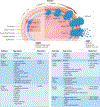Advances in bladder cancer biology and therapy
- PMID: 33268841
- PMCID: PMC10112195
- DOI: 10.1038/s41568-020-00313-1
Advances in bladder cancer biology and therapy
Abstract
The field of research in bladder cancer has seen significant advances in recent years. Next-generation sequencing has identified the genes most mutated in bladder cancer. This wealth of information allowed the definition of driver mutations, and identification of actionable therapeutic targets, as well as a clearer picture of patient prognosis and therapeutic direction. In a similar vein, our understanding of the cellular aspects of bladder cancer has grown. The identification of the cellular geography and the populations of different cell types and quantifications of normal and abnormal cell types in tumours provide a better prediction of therapeutic response. Non-invasive methods of diagnosis, including liquid biopsies, have seen major advances as well. These methods will likely find considerable utility in assessing minimal residual disease following treatment and for early-stage diagnosis. A significant therapeutic impact on patients with bladder cancer is found in the use of immune checkpoint inhibitor therapeutics. These therapeutics have been shown to cure some patients with bladder cancer and significantly decrease adverse events. These developments provide patients with better monitoring opportunities, unique therapeutic options and greater hope for prolonged survival.
Conflict of interest statement
Competing interests
D.T. is on the scientific advisory board for Urogen. J.E.D. receives compensation from Invitae. The other authors declare no competing interests.
Figures



References
-
- Bray F et al. Global cancer statistics 2018: GLOBOCAN estimates of incidence and mortality worldwide for 36 cancers in 185 countries. CA Cancer J. Clin 68, 394–424 (2018). - PubMed
-
- Lindgren D et al. Combined gene expression and genomic profiling define two intrinsic molecular subtypes of urothelial carcinoma and gene signatures for molecular grading and outcome. Cancer Res 70, 3463–3472 (2010). - PubMed
-
- Sjodahl G et al. A molecular taxonomy for urothelial carcinoma. Clin. Cancer Res 18, 3377–3386 (2012). - PubMed
Publication types
MeSH terms
Substances
Grants and funding
LinkOut - more resources
Full Text Sources
Other Literature Sources
Medical

